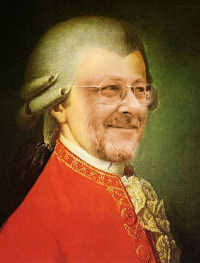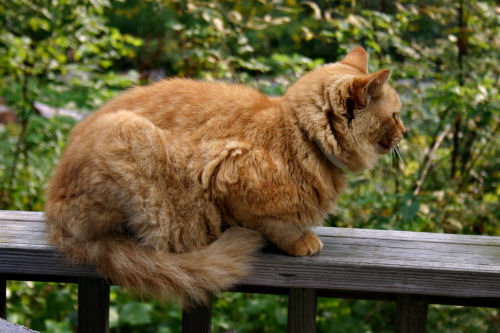A 365-Day Project
"We Are All Mozart"
A project to create
new works and change
the perception of the
music of our time.


 September 12, 2006
September 12, 2006 
There was a wonderful opportunity to promote new nonpop on Sunday at the National Extension Tourism Conference, fortuitously held this year in Burlington, Vermont. Some months ago, I made a convincing case to the organizers that new nonpop was good for tourism, and they handed me the conference's Sunday evening presentation to make the case to the rest of the local tourism promoters from around the country.
To my surprise, the welcome was enthusiastic -- so much so that it might be worth pursuing by other composers with their local tourism boards. As opposed to arts councils, tourism folks are always looking for new ideas and can move quickly, with private funds, and proceed with an 'uncontaminated' point of view.
After introducing myself as a lifelong composer who also wears hats as a writer and director of the Vermont Alliance of Independent Country Stores (a credibility issue that I have observed), I took the group right into the question: What can you write in a day? The Exequy from 1971 was the first piece on a list of one-day pieces projected behind me -- a PowerPoint presentation (which you can get and tailor to your liking). The list flashed by and concluded by noting that five years ago was September 11, 2001, shortly after which sixty composers had contributed to a musical gallery of memorial compositions.
The point about composer responsiveness and professionalism seemed well taken, so I went on to a brief explanation of the term "nonpop" -- and to my surprise, this group thought the word was a welcome relief (including the 'classical' listeners in the room). With the idea that "nonpop" was about as negative as "nonfiction" or "nonfat", and could be thought of as "the music that used to be called classical," the argument was sealed.
At last it was time for the project's premise: that we composers can work with quality, quantity, demand and imagination ... just as Mozart had done in his own cultural milieu. Something had changed in the course of musical history from Mozart to us, and composers could do more and do better. Demand creates demand. For contrast, I related the story of Debussy -- that he could not finish an opera in three months because it took him that long to decide between two chords.
Artists like Debussy make good stories. But if we can ask our teachers to go into the classroom every day and come up with solutions to education, then we can ask that kind of commitment from our artists. Likewise, our journalists must be literate, coherent, and reveal something to the reader every day. We can do that. Every person with a creative part to their daily work considers how much is self-motivated, even if most of what they do is demanded by others, save for a small niche of artists (mostly composers, it seems). So the project is assessing the psychology of composition by the composers themselves.
The group appreciated the idea of bringing nonpop back into the day-to-day lives of people, and figuring out a mechanism to do it such as "We Are All Mozart," a project that could be emulated by communities everywhere. The rhetorical question hanging in the air was still "why do it." Looking at the state of the art provided some illustration for the group: that 'the top' of the classical world was a disaster, with orchestras playing the same classical Top Forty repertoire and still going bankrupt, and even National Public Radio canceling the bulk of its classical programming.
In preparation for the talk, I'd taken a look at the New York Philharmonic's 2006-2007 season, wherein they will play concerts totaling 285 compositions. Who were the stars? Mozart [21], Beethoven and Brahms [17 each], Sibelius, Shostakovich and Vivaldi [8], Tchaikovsky and Stravinsky [7], Richard Strauss [6], Debussy and Schubert [5], Handel, Bach, Verdi, Ravel, Weber, Mendelssohn, Ligeti and, Hindemith [4], Puccini, Bartók, Dvorák and Roussel [3]. With two each were Mahler, Saint-Saëns, Respighi, Elgar, Bruckner, Moussorgsky, Schumann, Haydn, Rossini, Salonen (he's the conductor, and European). Following up with one each were Mascagni, Bruch, Gabrieli, Purcell, Prokofiev, Rachmaninoff, Corelli, Boccherini, Vaughan Williams, Arensky, Copland, Scriabin, Tomasi, Gould, Khachaturian, Schifrin, Moszkowski, Piazzola, Korngold, Martucci, Berlioz, Gershwin, Ibert, Thuille, Rameau, Chausson, Schoenberg, Suk, Berg, Rimsky-Korsakov, Cherubini, and Webern.
Oh, yes, there were newer composers, with one each by Hans Werner Henze (1926), Jon Deak (1943), Daniel Börtz (1943), John Adams (1947), Christopher Rouse (1949), Kaija Saariaho (1952) and Melinda Wagner (1957). The total? 285 pieces. Fifteen by dead Americans, if you include the eight by the naturalized Stravinsky and Schoenberg. Nine by living composers, five by living Americans, and just one by by a composer under fifty years old.
Even here in town, the Vermont Symphony's own list was comprised of Beethoven, Mozart, Tchaikovsky, Haydn, Shostakovich, Ibert, Dvorak, Hindemith, Moussorgsky, Ravel, Schumann, Brahms, Dukas, Kechley, Prokofiev, Hamlin, Bartók, Fauré, Rossini, Weber, Smetana, Holst, Grofé, John Williams, Leroy Anderson, Rodgers & Hammerstein -- one living nonpopper among them.
After the shock and a grand pause, it was critical to mention that nonpop hadn't gone all irrelevant -- it had gone grassroots. The number of working composers is still rising, the number of new nonpop ensembles at the grassroots level is also rising, and web radio is presenting the widest selection of new nonpop available in all of history. And these tourism promoters were working at the grassroots level.
The group was there for three days to learn how it could improve tourism. The arts offered an opportunity. Other massed projects exist. In computer art Le 365 Jours de Stéphane Trois Carrés by the eponymous French artist; in theatre, 365 Days / 365 Plays of Suzan-Lori Parks, starting at New York's Public Theatre; in painting, A Painting a Day wherein Nick Jainschigg will paint every day and offer them for sale; and even in Vermont, the Palettes of Vermont, a very homey project of painting palettes (not painting paintings), originated by Warren Kimble.
How could a composition project like "We Are All Mozart" help them like these other projects? I offered this list:
- Engages in a new approach to art in America, especially composing. Art has been limited to schools. Do you make it in daily life? Why not? Here's an opportunity.
- Centers around the local, grassroots activities. Local organizations are more nimble in commissioning and performing, and don't have to wait for a visit from 'great artists'.
- Brings community together around something fascinating and new. Whenever new artworks are made, there is buzz, especially surrounding performances.
- Creates music entirely unique to the community or organization. This music is written only for you and only you, and carries your name forever.
- Creates a repeatable, multiple-use artform of lasting value. Think of alma maters, school songs, shows, plays, and how many ways it can be used and re-used.
- Uses a real-time participation artform. Think of sports, street events, parades, and how it can be played by every new generation of musicians in town.
- Invests in a multiple-participant artform. It belongs to everyone -- composers, musicians, and listeners, and can be use it in schools, public events, weddings, dedications.
- Helps organizations cash in now -- while it's cheap! At least for now, a musical composition is high, lasting value for small investment.
During the talk, there were also quick breaks to play excerpts of the day-pieces from the list projected at the beginning. Why do people at public events -- from weddings to horse shows, parades to parties -- grab off-the-shelf music when original and memorable music can be written? Why would one hire an ensemble to play dead Mozart again? Why grab Wind Beneath My Wings for vows when a local composer is at the ready? Composers do it. Wagner did it. Stravinsky did it. Berlioz did it. Bach did it. Mozart did it. Creating for events is a long-standing tradition among artists -- to paint portraits and sculpt busts and write sonnets and compose music.
There were five final points to tie up the first half of the talk:
- Do you know any living composers? In your community? Find them -- even by searching online, where many composers have migrated for opportunities.
- Mozart existed in a milieu where his work was wanted. All kinds of music is wanted, and there is an easy way to 'want' new nonpop, right at home.
- Pressure can create brilliant work. Exploit the drama! Bring news media to the events, make it part of a special occasion.
- Distinguish integrity (‘art’) and value (‘commerce’). We know when our work is good, no matter what we are offered in compensation.
- Restore a sense of societal, not just commercial, meaning to nonpop music written in our time.
Finally, having not shut up, it was time to put up. What strange requests might a composer be asked to write 'about' -- and I explained that writing 'about' something was tricky with non-descriptive art like music. But why not engage in the thinking process anyway? What if, I asked, someone handed you this (and a photograph was projected behind me) and asked you to write that music?
The photo was a cat.
The laughter was raucous. I could do a cute cat piece, I said, but why not something more unusual, something with a compelling backstory? And what followed was a PowerPoint outline of a composition [note: 12MB file] -- melody, top of cat; counterpoint, bottom of cat; rhythm, rail spindles; descending drone, hand rail. Textures from soft-focused leaves; delicate fur; bold wood. Dynamic feel from the fur's color changes. Harmonies from the green foliage. And focus on the cat's countenance for the structure.
Then came a 'piano roll' drawing that followed the four contours, and a cat overlay. They were still laughing. I played a rough copy, and laughter turned to surprise. Then followed a 35-second string quartet introduction that used the same material, massaged for musicality. (There is a score.) I had done this yesterday for them, and the deeper meaning of this nonpop artform suddenly rose to the surface.
So that was the evening. A good time was had by all, and the printed copies of the PowerPoints and the CDs were snapped up to be taken back to North Carolina and Maine and California and Arkansas and dozens of other states. Perhaps somewhere nonpop will have a little more new life, and composers a new public face.

Can you compose a cat? Clearly Orangeboom doesn't think it is possible. But his form was made in sound.